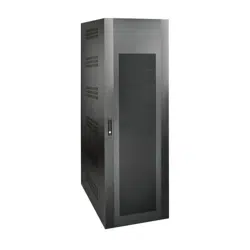Loading ...
Loading ...
Loading ...

7
4. Operation and Charging
4.1 Determine Charging Voltages
To determine the appropriate equalization (freshening) charge voltage and float charge voltage, multiply the number of batteries connected in
series in the battery cabinet by the recommended charging voltage per unit.
For example:
A +/- 240V DC cabinet containing 40 CSB GPL12100* batteries in series would use the following charging voltages:
Float Charge Voltage = 20 x (13.5 to 13.8V DC/unit average) = +/- 270 to 276V DC
4.2 Initial Charge
After the correct charging voltages have been calculated, follow these steps:
1. Adjust the charger/rectifier equalization and float voltage outputs to the appropriate level.
2. Place the charger/rectifier in equalization mode. Tripp Lite SmartOnline UPS units adjust the charging voltage level automatically based on
present battery voltage.
3. Close the disconnect switch/circuit breaker connection from the charger/rectifier to the battery cabinet(s) and start a 24-hour freshening
charge at the equalization charge.
4. After a few minutes on charge, monitor the voltage across several of the individual batteries to assure they are charging at the proper
value.
5. Following completion of the freshening charge, place the charger/rectifier in float charge mode. Tripp Lite SmartOnline UPS units adjust
the charging voltage level automatically based on the status of the battery voltage.
6. After the battery cabinet has been on float for an additional 1 to 24 hours, complete the operational check (see Section 4.3 below).
4.3 Operational Check
1. Measure and record the total system float voltage. Measure at the battery terminals.
2. Measure and record the system float current using a clamp-on ammeter.
3. Measure and record the float voltage of individual battery units.
4. Measure and record the temperature of several batteries. Measure battery temperature with a digital thermometer by placing the surface
thermocouple on the flat surface of the negative terminal—not the “L” connection surface. An infrared temperature monitor may also be
used.
5. Optional: Perform impedance and conductance tests on individual battery units. These tests require special equipment, but the data can
be useful in trending the system over time or identifying suspect units during later periodic checks. It may be necessary to disconnect the
battery system from the charger/load during these checks.
5. Maintenance
The battery cabinet contains valve-regulated recombinant lead-acid (VRLA) batteries, which are maintenance-free relative to the electrolyte.
You cannot add water to these batteries or sample the electrolyte specific gravity. It is necessary, however, to periodically check the charging
voltage, temperature and connections of the individual battery units.
5.1 Maintenance Schedule
5.1.1 Quarterly Check
Quarterly maintenance by qualified service personnel is recommended.
Loading ...
Loading ...
Loading ...
